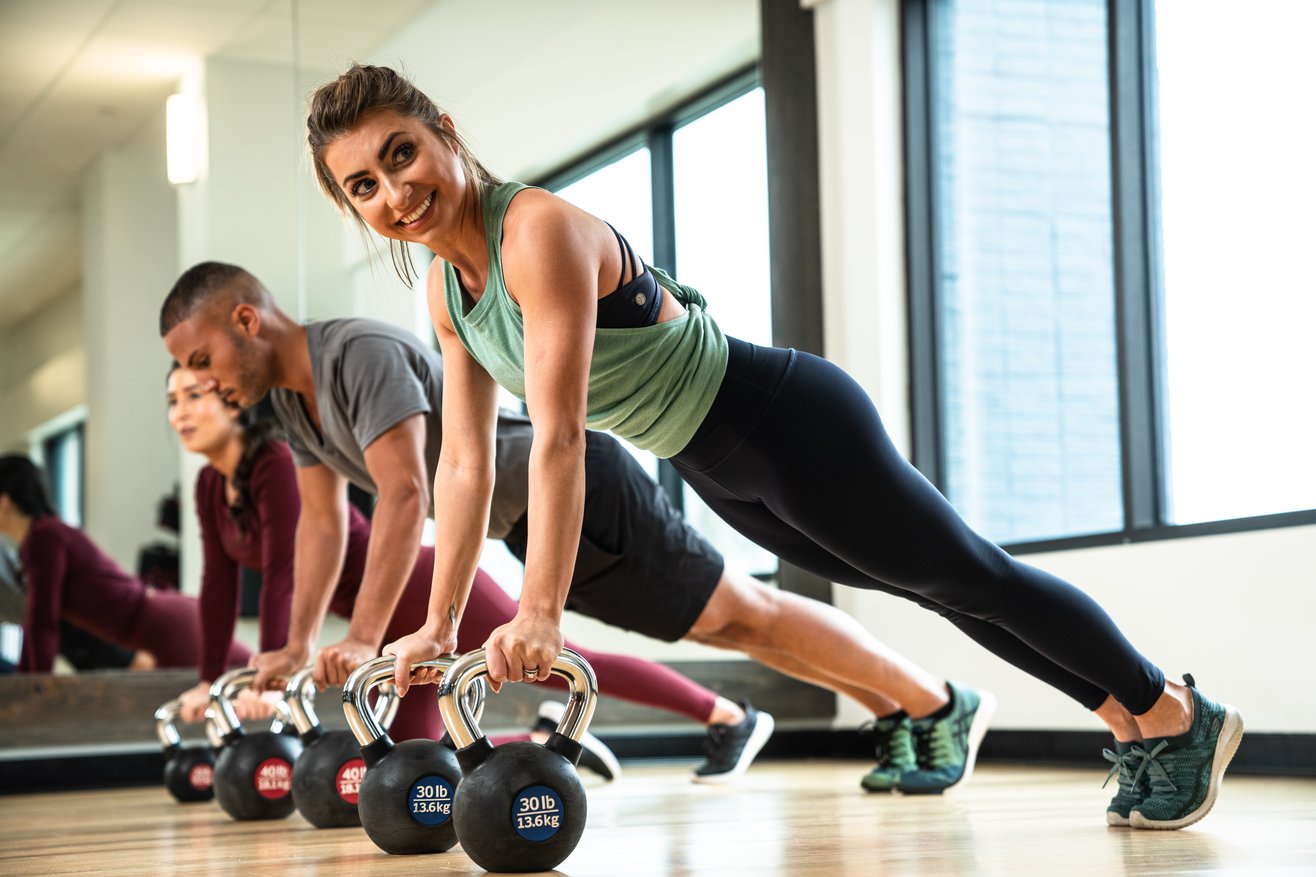The Ultimate Guide To High-Intensity Interval Training
The Ultimate Guide To High-Intensity Interval Training
Are you struggling to shed pounds while also wanting to bulk up in all the right places? You're not alone. Discover High-Intensity Interval Training (HIIT): It bridges this gap – efficiently burning fat and simultaneously encouraging muscle growth. Welcome to our Ultimate Guide to HIIT.
We're thrilled to explain how incorporating HIIT into your routine can revolutionize your workouts. Prepare for a game-changing shift in your approach to fitness.
Ready to work out? Get your FREE PASS to Onelife Fitness and try our HIIT classes today!
Key Takeaways
- High-Intensity Interval Training (HIIT) mixes short, intense bursts of exercise with rest periods to burn fat and build muscle. It's great for people who want to get fit but lack time.
- You can do HIIT using exercises like Tabata training, burpees, high knees, jump squats, and push-ups. These workouts can be done anywhere without needing a lot of equipment.
- When adding HIIT to your routine, it's essential to plan. Decide on your goals, pick the right exercises for those goals, and choose how hard and long you'll work out before resting. Make sure you have days off between HIIT sessions.
- To avoid injuries while doing HIIT, start warming up properly; focus on keeping good form during exercises; increase intensity slowly; take regular rest days; listen to your body's needs; stay hydrated; consider getting advice from a professional trainer.
- Studies say doing HIIT reduces body fat more effectively than longer cardio sessions. However, balancing different types of workouts is critical since too much aerobic exercise might not be suitable for your health.
Overview of High-Intensity Interval Training
.png?width=1316&height=878&name=211119_OneLife_Shot02_LowerTurf_1433FEDITED%20copy%20(1).png)
High-Intensity Interval Training, or HIIT, involves short bursts of intense exercise followed by brief periods of rest or lower-intensity activity. It offers a range of benefits, such as improved cardiovascular health, increased metabolism, and efficient use of time for busy individuals.
Definition
High-intensity interval Training, or HIIT, involves short bursts of intense exercise alternated with periods of rest or low-intensity activity. This type of training can boost muscle-building and fat-burning abilities. It's designed to push the body's aerobic and anaerobic systems, increasing overall fitness quickly.
Tabata training is a form of HIIT training that consists of 20 seconds of maximum effort followed by 10 seconds of rest. This method significantly improves aerobic capacity and requires at least 48 hours for full recovery due to its impact on the central nervous system.
For those aiming to reach their fitness goals, incorporating interval workouts requires equipment such as barbell complexes and strongman intervals into routines that can offer substantial benefits without excessive cardio's harmful effects on hormone levels and health.
Benefits

HIIT, or high-intensity interval training, packs a punch for muscle building and fat burning. It's a powerhouse for those looking to improve their physique without changing their diet.
Studies show that HIIT can slash body fat and boost muscle mass effectively. This approach to fitness is not just about losing weight; it nurtures strength and endurance, too.
Tabata training, a form of HIIT, proves you don't need hours on the treadmill to increase your maximal aerobic capacity. Just four minutes of Tabata can rival 45 minutes of slow cardio done four times weekly.
This makes HIIT the ultimate guide to getting fit fast, perfect for anyone at Onelife Fitness who values efficiency in their workout routine. Now, let's dive into how your trainer can incorporate this powerful method into your exercise regimen.
How to Incorporate HIIT into Your Workout Routine
Incorporate HIIT into your workout routine by choosing exercises that target different muscle groups. Design a personalized HIIT plan focusing on short bursts of intense activity and brief rest periods.
Exercises for HIIT

High-intensity interval training (HIIT) can transform your fitness routine by blending short, highly intense workouts. These exercises often require little equipment and can be done almost anywhere.
-
Tabata Training: This involves 20 seconds of maximum effort followed by 10 seconds of rest. Repeat this cycle for four minutes. Exercises like high knees, push-ups, and burpees fit perfectly into Tabata.
-
Barbell Complexes: Combine different barbell exercises without resting in between. This could include squats, rows, and presses. It's a full-body workout that boosts strength and endurance.
-
Strongman Intervals: Use heavy lifting exercises typically found in strongman competitions, like tire flips or farmer's walks, for short bursts of 30 seconds to a minute with equally short rest periods.
-
Burpees: A staple HIIT exercise that works your entire body. Jump up, drop down into a push-up position, do one push-up, then jump back up.
-
Walking: Though it seems low impact, alternating brisk walking with fast-paced walking can be an effective HIIT workout for beginners or those looking for lighter options.
-
High Knees: Run in place, raising your knees as high as possible at a rapid pace. This increases heart rate quickly, making it an excellent choice for HIIT.
-
Jump Squats: Perform a regular squat followed by an explosive jump upwards. Land softly and move right into the next squat.
-
Push-ups: Traditional push-ups become part of an intense HIIT circuit when done rapidly or with variations like clap push-ups for increased difficulty.
Creating a HIIT Workout Plan
After incorporating the exercises for HIIT into your routine, it's essential to strategically create a HIIT workout plan. Here's how to do it:
-
Determine Your Goals: Decide if you want to focus on fat loss, muscle building, or overall conditioning.
-
Choose Your Work and Rest Intervals: Opt for shorter, intense work intervals followed by adequate rest periods.
-
Select Your Exercises: Include a variety of bodyweight, cardio, and resistance exercises to target different muscle groups.
-
Plan Your Weekly Schedule: Incorporate HIIT workouts 1-3 times per week with adequate rest days in between.
-
Track Your Progress: Record your workouts and make necessary adjustments as you progress towards your fitness goals.
Tips for Preventing Injury
After creating a HIIT workout plan, it's crucial to consider tips for preventing injury:
-
Start with a proper warm-up routine to prepare your muscles and joints.
-
Always maintain correct form during exercises to reduce the risk of injury.
-
Gradually increase the intensity of your HIIT workouts to prevent overexertion.
-
Incorporate regular rest days into your routine to allow for adequate recovery.
-
Listen to your body and avoid pushing through severe pain or discomfort.
-
Ensure proper hydration before, during, and after your HIIT sessions.
-
Consider seeking professional guidance from a certified personal trainer.
Conclusion
High-intensity interval Training (HIIT) is a proven method for effectively building muscle and burning fat. Studies show that HIIT can lead to more incredible body fat loss compared to steady-state cardio.
Balancing aerobic activity with HIIT is crucial, as excessive aerobic exercise can harm the body. This Ultimate Guide To High-Intensity Interval Training provides a complete guide with valuable insights and recommendations for incorporating HIIT into your fitness routine.
FAQs
1. What is Intense Interval Training (HIIT)?
High-intensity interval Training, or HIIT, involves intense interval training sessions alternating between hard workouts and short rest periods.
2. Does HIIT require special equipment?
No, HIIT doesn't always need equipment. You can perform many exercises using body weight, but adding weights can increase intensity.
3. Can anyone do HIIT?
Yes, with modification options available in pre-planned exercise routines, beginners and experts can adapt HIIT to their fitness levels to prevent injury.
4. How does HIIT benefit my health?
HIIT improves glucose metabolism, increases VO2 max for better aerobic endurance, reduces visceral fat, aids in fat loss, and enhances mental health by potentially decreasing depression symptoms.
5. Will I see results quickly with HIIT?
Yes! Due to its intense nature and how it challenges your body differently than traditional workouts, you may notice increased strength and aerobic capacity sooner.
6. Where can I find more information on HIIT?
"The Ultimate Guide to High-Intensity Interval Training" by author Alex Geissbuhler offers comprehensive insights into effective workouts and harder techniques and is available at retailers like Amazon.com for purchase or download on Kindle.
Contact Onelife Fitness for your FREE PASS and all our gym classes across GA, MD, VA, DC & WV. We look forward to helping you on your health and fitness journey!